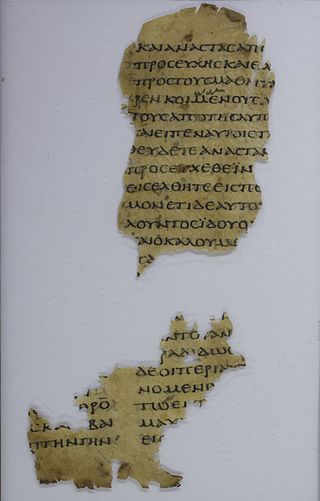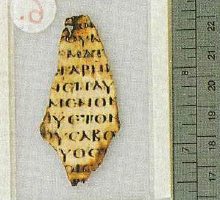Related Research Articles

The "Magdalen" papyrus was purchased in Luxor, Egypt in 1901 by Reverend Charles Bousfield Huleatt (1863–1908), who identified the Greek fragments as portions of the Gospel of Matthew and presented them to Magdalen College, Oxford, where they are catalogued as P. Magdalen Greek 17 from which they acquired their name. When the fragments were published by Colin Henderson Roberts in 1953, illustrated with a photograph, the hand was characterized as "an early predecessor of the so-called 'Biblical Uncial'" which began to emerge towards the end of the 2nd century. The uncial style is epitomised by the later biblical Codex Vaticanus and Codex Sinaiticus. Comparative paleographical analysis has remained the methodological key for dating the manuscript, but there is no consensus on the dating of the papyrus. Estimates have ranged from the 1st century to the 4th century AD.

There have been many Coptic versions of the Bible, including some of the earliest translations into any language. Several different versions were made in the ancient world, with different editions of the Old and New Testament in five of the dialects of Coptic: Bohairic (northern), Fayyumic, Sahidic (southern), Akhmimic and Mesokemic (middle). Biblical books were translated from the Alexandrian Greek version.

Uncial 0171, ε 07 (Soden) are two vellum leaves of a late third century Greek uncial Bible codex containing fragments of the Gospel of Matthew and the Gospel of Luke. The Luke fragment, in two parts, is preserved in the Laurentian Library collection in Florence, and the Matthew fragment is in the Berlin State Museum.
Codex 0205. It is a diglot Greek-Coptic (Sahidic) uncial manuscript of the Epistle to Titus and the Epistle to Philemon, dated paleographically to the 8th century.

Lectionary 1602, designated by ℓ1602 in the Gregory-Aland numbering, is a Coptic–Greek bilingual manuscript of the New Testament, on parchment leaves, dated paleographically to the 8th century.
Uncial 0114, ε 53 ; is a Greek–Coptic diglot uncial manuscript of the New Testament, dated palaeographically to the 8th-century.
Uncial 0164, ε 022 (Soden), is a Greek-Coptic bilingual uncial manuscript of the New Testament, dated paleographically to the 6th century.
Uncial 0200, is a Greek-Coptic diglot uncial manuscript of the New Testament, on parchment. Palaeographically it has been assigned to the 7th century. The manuscript has survived in a very fragmentary condition.
Uncial 0204, is a Greek-Coptic diglot uncial manuscript of the New Testament, dated paleographically to the 7th century.
Uncial 0237, ε 014, is a Greek-Coptic uncial manuscript of the New Testament. Paleographically it has been assigned to the 6th-century.

Uncial 0238, is a Greek-Coptic uncial manuscript of the New Testament. Paleographically it has been assigned to the 8th century.
Uncial 0242, is a Greek uncial manuscript of the New Testament. Paleographically it has been assigned to the 4th century.

Uncial 0252, is a Greek uncial manuscript of the New Testament. Paleographically it has been assigned to the 5th century.
Uncial 0267, is a Greek uncial manuscript of the New Testament. Palaeographically it has been assigned to the 5th century.
Uncial 0271, is a Greek uncial manuscript of the New Testament. Paleographically it has been assigned to the 9th century.
Lectionary 962, is a Greek-Coptic uncial manuscript of the New Testament. Paleographically it has been assigned to the 8th century.
Uncial 0277, is a Greek-Coptic uncial manuscript of the New Testament. Palaeographically it has been assigned to the 7th or 8th century.
Uncial 0299, is a Greek-Coptic diglot uncial manuscript of the New Testament. Palaeographically it has been assigned to the 10th or 11th century.
Uncial 0300, is a Greek uncial manuscript of the New Testament. Palaeographically it has been assigned to the 6th or 7th century.
Lectionary 143, designated by siglum ℓ143 is a Greek manuscript of the New Testament, on parchment leaves. Palaeographically it has been assigned to the 8th-century.
References
- 1 2 3 4 Aland, Kurt; Aland, Barbara (1995). The Text of the New Testament: An Introduction to the Critical Editions and to the Theory and Practice of Modern Textual Criticism . Erroll F. Rhodes (trans.). Grand Rapids: William B. Eerdmans Publishing Company. pp. 127–128. ISBN 978-0-8028-4098-1.
- 1 2 "Liste Handschriften". Münster: Institute for New Testament Textual Research. Retrieved 25 April 2011.